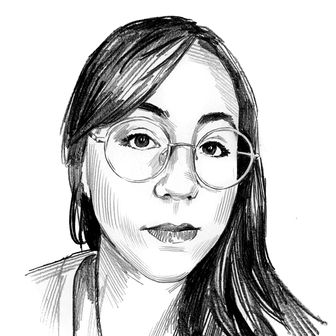
On January 23, 2024, Elemental was nominated for a Best Animated Feature Film Oscar.
Is there such a thing as a universal immigrant story? Pixar makes an unsteady go at telling one in its new movie, Elemental, an interracial romance set in a fantastical urban melting pot where beings made of water, earth, air, and fire live alongside one another. Element City is a community of immigrants, as explained by a series of murals near its port, but the fire people — who count the film’s heroine, Ember Lumen (Leah Lewis), in their number — are the latest and therefore the least integrated arrivals. To make it clear they aren’t meant to correspond with any particular group of real people, Elemental presents them as a melange of signifiers of foreignness. Fire food is spicy, fire English is accented, fire script is vaguely idiographic, and fire customs include maintaining an altar of blue flame from the homeland and doing a deep bow as a sign of respect. Some details have direct historical resonance: Ember’s parents’ names get anglicized, Ellis Island–style, into Bernie (Ronnie del Carmen) and Cinder (Shila Ommi) upon arrival, and after being denied housing elsewhere, the family takes up residence in a bedraggled neighborhood that grows into a Chinatown-like enclave. But the cultural traditions to which they owe the most are other movies about cross-generational immigrant angst. Shorn of specificity, all that’s left for the Lumens are clichés.
Elemental is the second feature from Peter Sohn, a Pixar stalwart who has been with the company since 2000 but as a director is now 0 for 2. The movie looks good — Element City teems with imaginative details about how its varied residents navigate life in close proximity — but its undercooked concept is a problem. The alternate-history premise of Sohn’s 2015 debut, The Good Dinosaur, also felt like it needed a few more passes, but it was set in a world dominated by dinosaurs that never went extinct, so the stakes felt lower. While Sohn has said Elemental was inspired by his parents, his upbringing in multicultural New York City, and his own mixed marriage, the lack of deeper consideration his film gives to its ideas leads to some ugly reductiveness. The Lumens, who run a market selling fire foods and imported specialties, are defined by their industriousness as well as their emotional constipation — Ember has explosive (literally) bursts of temper over the fact that she doesn’t actually want to take over the store from her father. Wade Ripple (Mamoudou Athie), the watery municipal inspector who becomes her love interest, is in contrast so open with his feelings that his family holds crying competitions. His mother, Brook (Catherine O’Hara), instantly spots and nurtures Ember’s glassmaking gifts, a talent her own parents barely register.
Written by John Hoberg, Kat Likkel, and Brenda Hsueh, the movie clearly means well, even as it ends up falling into stereotypes about minority isolation, strictness, and crushing filial expectations. But it also hollows out and makes generic the real-world concerns it uses as reference points, creating a metaphor for racial divides without exploring what causes them. Ember and her community stay in Fire Town because the rest of the city isn’t designed for them and, from what we’re shown, they haven’t been welcome there. Yet the solution the film offers is that Ember simply needs to get over her fears, deal with the occasional microaggression, and bridge differences with love. The romance in Elemental can’t help but be underwhelming because it also has to stand in for the movie’s feelings about assimilation. Wade, who has the eager, uncomplicated personality of a golden retriever, falls for Ember quickly and fully, tells his family about her, and never has to change. Ember is the one who has to unencumber herself from feelings of guilt over the sacrifices her parents have made and open up about what she really wants.
Ember is a girl on fire, her body made out of flames that rise to peaks with her upturned nose and skyward-tilting hair. In the dark, she’s luminous, and if she comes into contact with water, she can be extinguished; when she feels great distress, she dwindles down as though in danger of going out completely. She zips around in goggles making deliveries on a scooter, a vehicle that comes into play later when a threat to her community has to be dealt with. She’s one of those expressive marvels of design that seem to come so effortlessly to Pixar, but she’s also a reminder that the company has, with the occasional exception, been off its game for years now after knocking out masterpiece after masterpiece. The visuals are still there, even if they’re not as exciting as what can be found a few theaters over in Spider-Man: Across the Spider-Verse. But the storytelling lately falls flat, as though some fundamental and once-core ability to calibrate between a kid-friendly tone and grown-up themes has been lost.
More Movie Reviews
- The Accountant 2 Can Not Be Taken Seriously
- Another Simple Favor Is So Fun, Until It Gets So Dumb
- Errol Morris Has Been Sucked Into the Gaping Maw of True Crime


